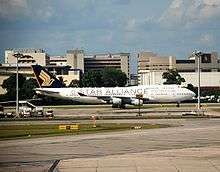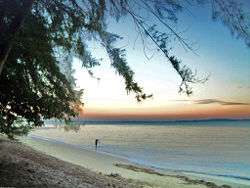Changi
| Changi | |
|---|---|
| Name transcription(s) | |
| • Chinese | 樟宜 |
| • Pinyin | Zhāngyí |
| • Hokkien POJ | Chiang-gî |
| • Malay | Changi |
| • Tamil | சாங்கி |
|
Sunset at Changi Beach | |
 | |
 Changi Location of Changi within Singapore | |
| Coordinates: 1°23′28″N 103°59′11″E / 1.39111°N 103.98639°ECoordinates: 1°23′28″N 103°59′11″E / 1.39111°N 103.98639°E | |
| Country | Singapore |
Changi is a planning area located in the East Region of Singapore. Sharing borders with Pasir Ris and Tampines to the west, Changi Bay to the southeast, the South China Sea to the east and the Serangoon Harbour to the north, Changi, excluding the two water catchments and islands of Singapore, is the largest planning area by land size.
Today, Changi is an aviation hub. It is the current location of both the Changi Airport and Changi Air Base.
Also located within Changi is Singapore's largest prison, Changi Prison. It became infamous as a Japanese prisoner-of-war camp during the occupation of Singapore in World War II. Changi Prison continues to be Singapore's oldest operating internment facility, in the form of the new Changi Prison Complex.
Etymology

The early Malay place name of Changi was Tanjong Rusa, as written the 1604 Godinho de Eredia map of Singapore.[1]
The name Changi was known in the early 19th century. In the 1828 map by Franklin and Jackson, the extreme southeastern tip of the island is referred to as Tanjong Changi. Vessels using the Johor Straits would have to pass by Changi.[2]
There are many versions for the etymological roots of the name Changi. The first director of the Singapore Botanic Gardens Henry Ridley suggested that it gets its name from a tall tree, called Changal (also written and pronounced as "Chengai") tree (Neobalanocarpus heimii, also known as Balanscorpus heimii or Balano scorpas), which was common in the area in the early nineteenth century. Its heavy timber is commonly used for buildings and furniture and noted for its strength and deep rich colour. Other sources suggests that it comes from a climbing shrub found in the area, the changi ular (Hopea sangal), or chengal asir (Apama corymbosa).[2]
During the early surveys in the 1820s to 1830s of Singapore island, Changi was also named Franklin Point after Captain Franklin who involved in these early surveys.[1]

Economy

Singapore Airlines is headquartered in Airline House, at Changi Airport in Changi.[3] SilkAir also has its head office in Airline House. Singapore Airlines Cargo has its head office in the SATS Airfreight Cargo Terminal 5. Jetstar Asia, Scoot, and Valuair have their head offices in Terminal 1 of the airport. Tiger Airways has its head office in the Honeywell Building in Changi Business Park Central 1[4]
Education
The Japanese School Singapore Changi Campus is in the community.[5]
See also
| Wikimedia Commons has media related to Changi. |
References
- 1 2 Victor R Savage, Brenda S A Yeoh (2004). Toponymics A Study of Singapore Street Names. Eastern University Press. p. 70. ISBN 981-210-364-3.
- 1 2 Vernon Cornelius. "Changi". Singapore Infopedia. National Library Board.
- ↑ "Airline Ground Positions." Singapore Airlines. Retrieved 11 July 2009.
- ↑ "Singapore Air Operators." (Archive) Civil Aviation Authority of Singapore. Retrieved 31 October 2012.
- ↑ "CHANGI CAMPUS." (Archive) The Japanese School Singapore. Retrieved 8 January 2014.
Sources
- Victor R Savage, Brenda S A Yeoh (2003), Toponymics – A Study of Singapore Street Names, Eastern Universities Press, ISBN 981-210-205-1
- Cornelius-Takahama, Vernon (16 March 1999), Changi, Singapore Infopedia, National Library Board, Singapore, archived from the original on 23 January 2010, retrieved 23 July 2009
